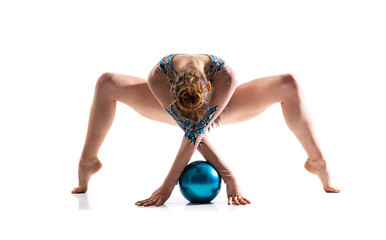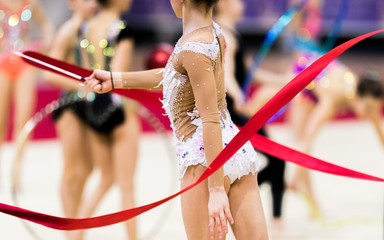To sign up for our daily email newsletter, CLICK HERE
Rhythmic gymnastics is a sport where women perform on the floor with musical accompaniment. Such performances can be freehand or use special apparatus designed for rhythmic gymnastics, such as ribbons, ropes, hoops, balls, etc. This sport is a perfect combination of gymnastics, dancing, ballet, and other sports elements. Each athlete competing in rhythmic gymnastics should have a lot of agility, coordination, strength, flexibility, and stamina. This type of gymnastics relies heavily on music choice, which makes each routine an unforgettable performance. In case you want to discover the best gyms for rhythmic gymnastics, high-quality equipment, and athletic wear or create special music cuts for your routine, visit Jenerg for professional help.

Where Did Rhythmic Gymnastics Originate?
Rhythmic gymnastics, as we know it today, first started appearing in Europe during the 19th century. Not until the 1950s, this kind of gymnastics has become its own independent sport in Russia. The first-ever official international competition for rhythmic gymnastics was held in 1963 in Budapest. The gymnast from the Soviet Union at that time, Ludmila Savinkova, has won first place in this historical championship.
Each of the apparatus used in rhythmic gymnastics nowadays was introduced at different times, and it has its own story. There are five different types of equipment in total. They are:
- Ball. This equipment was already present in the first official competition. A ball used for gymnastics can be plastic or rubber.
- Hoop. Back in the 1930s, this one was already popular among athletes, but not until the 1960s, it became an official apparatus for rhythmic gymnastics. It can be plastic or wooden.
- Rope. Only in 1965, this simple equipment became official for gymnasts. Ropes should be made of hemp.
- Ribbon. This type of equipment has been popular for a long time as well, but it became official in the 1971 competition. Each ribbon should be exactly seven meters, and the required material is satin.
- Club. This one was introduced in an official competition in 1973. Historically, clubs were special weapons popular in some countries.
When Was Rhythmic Gymnastics Invented?
Rhythmic gymnastics is a sport that originates from many different other sports. This is, of course, a fully independent sport, even though it comprises elements from ballet and various types of exercising. Swedish exercise system, which helps with developing rhythm, and German muscle developing system are specific disciplines that had a huge impact on forming rhythmic gymnastics. The first traces of this kind of gymnastics could be seen back in the 19th century in a form of group gymnastic competitions. The exact date of inventing rhythmic gymnastics is unknown as this sport went through many years of changes and transformations until it became the gymnastics we know and love today. As for the official date, rhythmic gymnastics has been recognized by FIG in 1961.

When Did Rhythmic Gymnastics Become an Olympic Sport?
The first appearance of rhythmic gymnastics at the Olympics was in 1984. This historical competition took place in Los Angeles. The first-ever athlete to win a gold medal for rhythmic gymnastics at the Olympics was Canadian gymnast Lori Fung. Up until the Olympics held in Barcelona, Spain, in 1992, this type of gymnastics had a single event in the competition. Group gymnastics performance was introduced during the Olympic Games of 1996 in Atlanta.
How Long Has Rhythmic Gymnastics been in the Olympics?
For 37 years already, rhythmic gymnastics has been represented at the Olympics. Since its first official appearance in 1984, each following Olympic Games competition has included this sport. Sixteen Olympics in total have been including rhythmic gymnastics up to this day. The next Olympic Games contest will be held in Tokyo, Japan, in the summer of 2021.
What Makes Rhythmic Gymnastics as a Sport?
There are numerous debates around rhythmic gymnastics being a sport, not to mention an Olympic sport. The main reason why so many people think that this type of gymnastics is less of a sport is the performance factor. Ignorance plays a huge role too as athletes will certainly recognize how challenging and demanding rhythmic gymnastics is. But for random viewers, such sport might seem frivolous because of various performance elements. Everything, from sparkly and bright-colored leotards to all kinds of music tracks and flowy ribbons, plays a huge role in each routine.
As rhythmic gymnastics was heavily influenced by ballet and other dance styles, it also feels a lot like a dance or performance. However, to present the routine with such ease, elegance, and grace, each gymnast has to go through an insane amount of physical training. Rhythmic gymnastics requires physical strengths, unbelievable flexibility, a perfect sense of rhythm, precision, and tons of other things. All the audience can see is throwing clubs and hoops and waving with the ribbons. But for athletes, it is crucial to make the apparatus do the exact thing they want without going anywhere or getting tangled. And all of this should be done while demonstrating the acrobatic wonders to the judges with a smile on your face.
What Is the Point of Rhythmic Gymnastics?
The point of rhythmic gymnastics is the same as of any other sport. The desire to compete and exceed in your work has been around since the dawn of time. Just like ice skaters, swimmers, football players, cyclists, divers, wrestlers, volleyball players, snowboarders, surfers, and all the other athletes, rhythmic gymnasts want to demonstrate the beauty and strengths of the human body and compete with other athletes to become the best in their craft.
But why rhythmic gymnastics and not another type of gymnastics or even sport? Rhythmic gymnastics is a unique sport that combines strength, beauty, and performance. Some might argue that this is the most beautiful sport ever. While different kinds of gymnastics have their similarities, rhythmic gymnastics stands out with its performative elements and apparatus. Artistic gymnastics also incorporates various equipment but uses it in a completely different way. With rhythmic gymnastics, all the ribbons, hoops, clubs, balls, and ropes act as an extension of the athlete to emphasize performance and beauty. And last but not least, rhythmic gymnastics is a women-only sport, while the others include all athletes.
What Is Used in Rhythmic Gymnastics?
There are five types of equipment incorporated in rhythmic gymnastics. They are ball, hoop, rope, ribbon, and club. Gymnasts compete solo or in groups of five using one or two of the apparatus listed above in their routine. They have to perform various elements while holding and throwing the equipment they use. Based on how precise they can manipulate their apparatus during the performance, athletes receive points. Each type of equipment should be made of certain material and correspond to strict specifications to comply with competition rules.